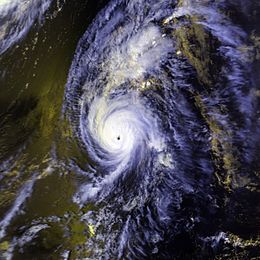Hurricane Iniki
| Category 4 major hurricane (SSHWS/NWS) | |

Satellite image of Iniki near peak intensity
|
|
| Formed | September 5, 1992 |
|---|---|
| Dissipated | September 13, 1992 |
| Highest winds |
1-minute sustained: 145 mph (230 km/h) |
| Lowest pressure | 938 mbar (hPa); 27.7 inHg |
| Fatalities | 6 direct |
| Damage | $1.8 billion (1992 USD) (Costliest hurricane in Central Pacific history) |
| Areas affected | Hawaiʻi (particularly Kauaʻi) |
| Part of the 1992 Pacific hurricane season | |
Hurricane Iniki (/iːˈniːkiː/ ee-NEE-kee; Hawaiian: ʻiniki meaning "strong and piercing wind") was the most powerful hurricane to strike the U.S. state of Hawaii in recorded history. Forming on September 5, 1992, during the strong 1990–95 El Niño, Iniki was one of eleven Central Pacific tropical cyclones during that season. It attained tropical storm status on September 8 and further intensified into a hurricane the next day. After turning north, Iniki struck the island of Kauaʻi on September 11 at peak intensity; it had winds of 145 miles per hour (233 km/h) and reached Category 4 on the Saffir–Simpson hurricane scale. It was the first hurricane to hit the state since Hurricane Iwa in the 1982 season, and the first major hurricane since Hurricane Dot in 1959. Iniki dissipated on September 13 about halfway between Hawaii and Alaska.
Iniki caused around $1.8 billion (1992 USD) of damage and six deaths. At the time, Iniki was among the costliest United States hurricanes, and it remains one of the costliest hurricanes on record in the eastern Pacific. The storm struck just weeks after Hurricane Andrew, the costliest tropical cyclone ever at the time, struck Florida.
...
Wikipedia
